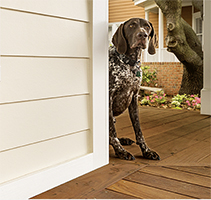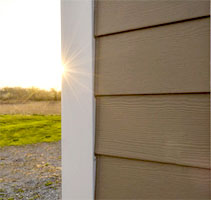by Erin Vaughan
9/19/2017
 Photo courtesy of Modernize.
Photo courtesy of Modernize.
A deck is just like anything else in your home: to maintain its lustre throughout the years, you’ll need to give it a little TLC every once in a while. Luckily, deck care is a lot less demanding than most other home maintenance jobs. In fact, a weekend of attention is all most decks require to keep in shape throughout the year. Here’s what to do and how to keep yours looking good as new all year long.
Give It a Wash
Decks can get pretty dingy after constant use and weather throughout the year, so a good wash is always welcome. And for many people, that means grabbing for the pressure washer, which can get the job done in half the time. The only problem is that high-pressure washes strip away paint and finish. So unless you plan on repainting or staining, keep it on a low pressure setting. You’ll also want to sweep loose debris and leaves off the surface first, then use the pressure washer to pry up any debris that has settled between the cracks between the boards.
Next, take a commercial deck cleaner and pour it into the detergent dispenser on the power washer. Make sure the formula you choose is rated for the surface, particularly if you have a wood deck—otherwise, you could bleach or damage the material. Use the spray gun to distribute the cleaning solution over the boards, working your way toward the edge of the deck. Keep the nozzle moving continuously to prevent the sprayer from gouging the wood. Use a scrub brush to loosen really stubborn grit or to spot treat stains. Allow the cleaning solution to sit on the deck for around ten minutes, or whatever length of time is recommended by the manufacturer, then give it a good rinse. Goodbye, deck grime!

Fix Any Damage
Since they’re regularly exposed to the elements, it’s not unusual for decks to need a little extra TLC from time to time, particularly after the winter. Usually, this amounts to nothing more than replacing a few boards and hammering some nails. To fix loose or popped nails, pry them up with a nail puller or the back of a hammer. Using a screwdriver, drive a new screw into the hole. This will keep the new fastener in place and help you avoid all those stubbed toes!
For cracked or rotting boards, you’ll need to dive in a little deeper. Here, the solution depends on the extent of the damage. For a small rotting section—something no bigger than about a square inch or two—an epoxy wood filler may be all you need. Chisel out the rotting section and apply the filler as instructed on the directions. If the section is larger than that, you’ll need something a bit more robust. For serious cracks or missing or rotted boards, that means replacing the piece with a whole new section of decking.

Photo courtesy of Modernize.
Seal, Repaint, or Restain the Deck Surface
A clean, damage-free deck offers the perfect opportunity for reapplying sealant, toner, stain, or paint, as well. Before you get too overwhelmed, remember that you might not have to do this every year. The frequency of this maintenance step depends on your deck, and what you use to protect it.
Generally, exterior paint or stain that’s made with an included protective sealant only needs to be reapplied biannually. If you prefer a natural or more transparent look, you’ll need to use a sealer or toner instead, which you should ideally redo once a year.
To prep the deck, lightly sand the surface using 80-grit sandpaper. Take a clean cloth, sponge, or swiffer pad and run it lightly over the surface of the deck to remove any flecks of sawdust. Then cover any stone veneers, nearby plants, air conditioners, or other equipment that may not fare well near a paint sprayer or roller.
If you’re painting, apply a coat of wood primer first and allow it to fully dry before continuing. Otherwise, use a paint sprayer or roller to cover the deck surface with your desired finish. Remember, sprayers will make the job go faster, but they’re a lot more difficult to manage, so make sure to try it out first and get a feel for it before you start in on the deck. Do about three or four boards at a time, applying the finish in a smooth, even coat. Use a small brush or sponge around railings, stairs, and other spots where it may be too difficult to maneuver the sprayer or roller. Allow the paint or stain to dry and set fully before going back out on your deck. Apply a second coat if necessary.
And that’s pretty much all you need to do to keep your deck looking great all year long. That wasn’t so bad, was it?
Erin Vaughan is a blogger, gardener and aspiring homeowner. She currently resides in Austin, TX where she writes full time for Modernize, with the goal of empowering homeowners with the expert guidance and educational tools they need to take on big home projects with confidence.





































